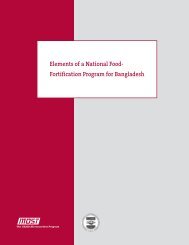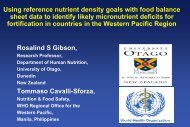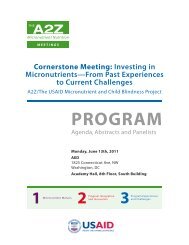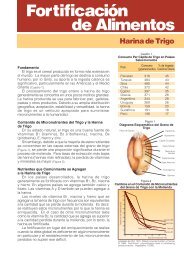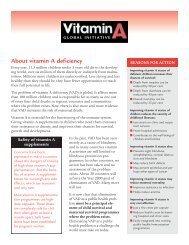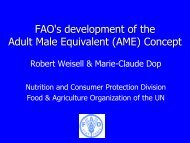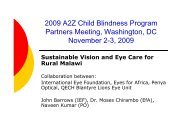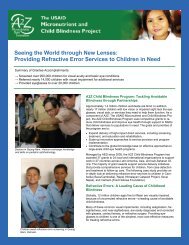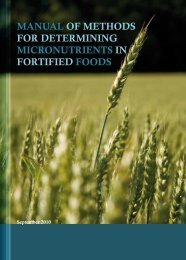Fortification of Vegetable oil and Sugar with Vitamin A in Uganda
Fortification of Vegetable oil and Sugar with Vitamin A in Uganda
Fortification of Vegetable oil and Sugar with Vitamin A in Uganda
You also want an ePaper? Increase the reach of your titles
YUMPU automatically turns print PDFs into web optimized ePapers that Google loves.
Annex 3:<br />
Adult Consumption Equivalents <strong>and</strong> Updat<strong>in</strong>g Future HIES Data <strong>with</strong> Data from the<br />
Makerere University 2008 Food Consumption Survey<br />
As noted <strong>in</strong> the text discussion <strong>of</strong> the HIES, the HIES provides important empirical <strong>in</strong>formation<br />
about the skewed right nature <strong>of</strong> the distribution <strong>of</strong> consumption, which should be regarded as<br />
preferable to simply mak<strong>in</strong>g some assumptions about these key parameters. Given the<br />
<strong>in</strong>formation void about <strong>in</strong>dividual consumption levels <strong>and</strong> the use <strong>of</strong> household purchases as its<br />
proxy, however, sett<strong>in</strong>g the amount <strong>of</strong> fortificant to be added to a vehicle still requires mak<strong>in</strong>g<br />
one or more assumptions about the <strong>in</strong>tra-household distribution <strong>of</strong> the household’s purchases <strong>of</strong><br />
the vehicle <strong>in</strong> question. The simplest approach makes use <strong>of</strong> the HIES <strong>in</strong>formation about<br />
household size <strong>and</strong> implicitly assumes that all <strong>in</strong>dividuals <strong>in</strong> the household receive equal<br />
amounts <strong>of</strong> the food. This approach does not take <strong>in</strong>to differences <strong>in</strong> the age or sex <strong>of</strong> household<br />
members, which (as reflected <strong>in</strong> the age- <strong>and</strong> sex-specific EARs) give rise to differences <strong>in</strong><br />
“need”.<br />
An alternative approach would be to make use <strong>of</strong> the HIES <strong>in</strong>formation about the number <strong>of</strong><br />
household members <strong>and</strong> their ages <strong>and</strong> sex <strong>and</strong> either (1) calculates the “adult consumption<br />
equivalents” (ACE) us<strong>in</strong>g the FAO algorithms (presented <strong>in</strong> the table below) which are based on<br />
energy requirements, or (2) <strong>in</strong> the case <strong>of</strong> analyz<strong>in</strong>g a s<strong>in</strong>gle micronutrient--vitam<strong>in</strong> A <strong>in</strong> this<br />
case—the vitam<strong>in</strong> A-specific EAR age <strong>and</strong> sex categories can be used to calculate vitam<strong>in</strong> A-<br />
specific-adult consumption equivalents.<br />
FAO Adjustment Factors for Calculat<strong>in</strong>g the<br />
Number <strong>of</strong> Adult Equivalent Consumption Units<br />
AGE MALE FEMALE<br />
< 1 year 0.27 0.27<br />
1 – 3 years 0.45 0.45<br />
4 – 6 years 0.61 0.61<br />
7 – 9 years 0.73 0.73<br />
10 – 12 years 0.86 0.78<br />
13 – 15 years 0.96 0.83<br />
16 – 19 years 1.02 0.77<br />
20 years <strong>and</strong> above 1.00 0.73<br />
While the ACE approach makes use <strong>of</strong> more detailed empirical data, it is important to note that<br />
its application implicitly assumes that the food purchased by the household is distributed <strong>with</strong><strong>in</strong><br />
the household <strong>in</strong> direct proportion to “need” as reflected <strong>in</strong> whichever <strong>of</strong> the two specific<br />
algorithms is applied. 24<br />
24 This simplify<strong>in</strong>g assumption “smoothes” the <strong>in</strong>tra-household distribution <strong>of</strong> food consumption, result<strong>in</strong>g <strong>in</strong> an<br />
underestimation <strong>of</strong> extreme values <strong>and</strong> thereby <strong>in</strong>creas<strong>in</strong>g the potential risk <strong>of</strong> push<strong>in</strong>g <strong>in</strong>dividuals who are outliers<br />
(<strong>in</strong> terms <strong>of</strong> their level <strong>of</strong> consumption <strong>of</strong> the food vehicle) over the UL for a given level <strong>of</strong> fortification.<br />
59





